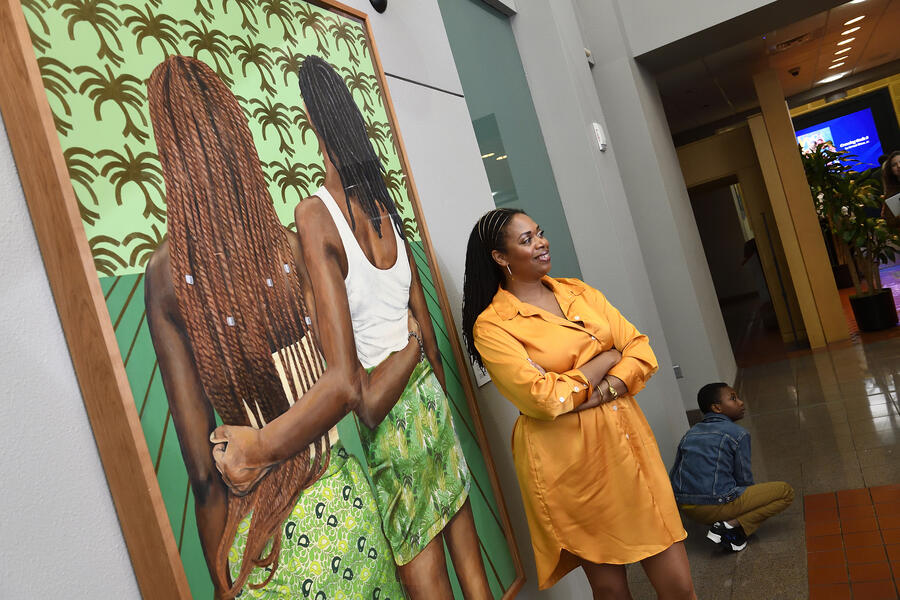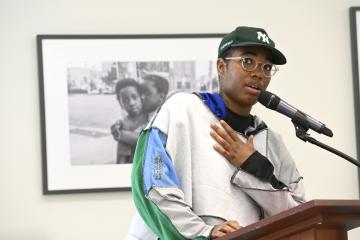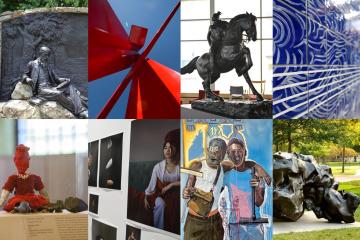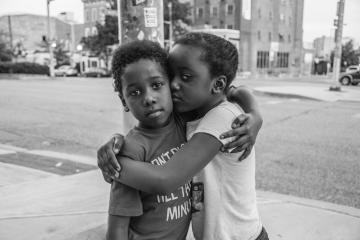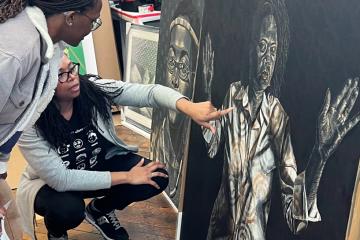Johns Hopkins University unveiled two new paintings by Baltimore-based artists Latoya M. Hobbs and Ernest Shaw Jr. in the Bloomberg School of Public Health's North Gallery last week.
Hobbs' painting, Sistership, uses vivid hues of green, gold, and brown to depict two Black women sharing an embrace while turned away from the viewer. The young squeegee workers in Ernest Shaw Jr.'s painting, Crossing Godz 5, also have their arms around each other and their faces obscured. Though they look out directly from the canvas, outlines of West African masks hide their features and elevate them to royalty. To complete the image of nobility, the two boys hold their squeegees like scepters.
The paintings were installed as part of the university's new public art initiative, which aims to uplift promising Baltimore artists and reflect the broader community by housing their works on Johns Hopkins' campuses. The effort, which involved an initial investment of $500,000 over two years and includes plans for future acquisitions, is an outgrowth of the university's Diverse Names and Narratives Project. The Art Collecting Committee, made up of students, faculty, staff, alumni, and trustee representatives, selected the works from an artist portfolio curated by BmoreArt consultants Cara Ober and Inés Sanchez de Lozada.
The installation ceremony included remarks from Bloomberg School Dean Ellen J. MacKenzie, members of the Art Collecting Committee, and the artists themselves.
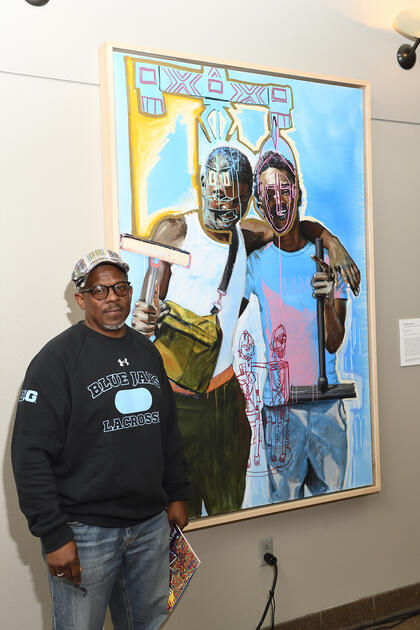
Image caption: Ernest Shaw Jr. with his painting Crossing Godz 5
Image credit: Will Kirk / Johns Hopkins University
"Let me just say how thrilled I am to have these pieces here," MacKenzie said in her welcoming address. "The art on our walls is an expression of the values we cherish. They show us the joy of human connection and reflect the power of Baltimore's artistic voices. They are a lasting testament to the connection between our school and our city, and a very strong reminder that we want that connection to continue to deepen and to grow."
Committee member Joseph Mayzck, associate director of design and construction for Johns Hopkins Facilities and Real Estate, recalled seeing Hobbs' artwork for the first time.
"We drove around Baltimore City, went to Clipper Mill, and walked into a very indiscriminate old building [that housed] the studio of Ms. Hobbs," Mayzck said. "You walk in, and there's piece after piece of artwork, and we were completely blown away by Sistership. It was a true display of togetherness and sisterhood and love that we all unanimously immediately backed [for selection]."
Annie Barnett, a selection committee member and doctoral candidate at the Whiting School of Engineering, experienced a similar feeling of awe entering Shaw's studio.
"Upon stepping into Ernest's studio at Station North Arts District, I was immediately exposed to the past, present, and future shared experiences of the Baltimore community," Barnett said. "And during Ernest's life as an artist and teacher within the greater Baltimore area, he has been dedicated to providing context to the day-to-day lives of this community through his art. These experiences are increasingly relevant in today's world, which is why the committee felt so strongly that Johns Hopkins should have the opportunity to engage and interact with Ernest's perspective."
The public arts initiative kicked off last summer with the installation of two black and white photographs by East Baltimore native SHAN Wallace. More artists are slated to have works displayed at the university, including painter Linling Lu, sculptor Sebastian Martorana, and photographer Elena Volkova.
Read more about Hobbs, Shaw, and other artists whose work is heading to Hopkins.
Posted in Arts+Culture
Tagged diversity, community, fine arts, school of public health, campus




